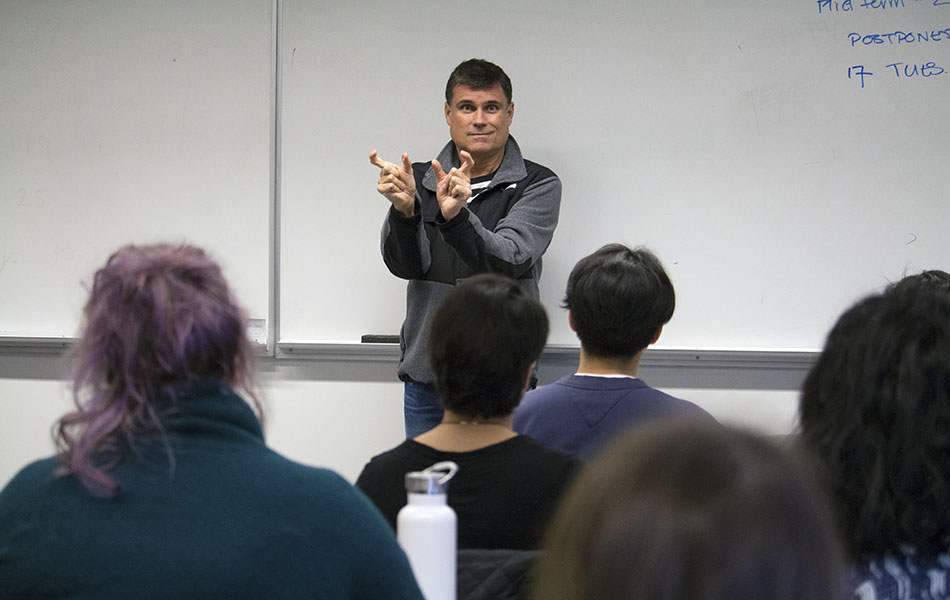You've likely seen Nigel Howard interpreting at the provincial COVID-19 briefings. You might even have joined his Facebook fan club. And come September, you'll be able to take American Sign Language (ASL) as an official credit course with him at the University of British Columbia.
Howard, an adjunct professor in the UBC Linguistics department and Language Sciences member, has attracted media attention (and a fan following) for his expressive interpretation of provincial health officer Bonnie Henry's COVID-19 updates. As the Vancouver Sun put it, "where she’s cool, he’s hot, interpreting with enthusiasm and expression." And in Winter I & II 2020-21, students can witness that enthusiasm first-hand in ASL 100 and 101, approved in April by UBC Senate.
Howard has been teaching a pilot course, LING 447 'Topics in Linguistics' at UBC, since 2018. Apart from this, ASL has not been available as a credit course at UBC (Extended Learning has non-credit courses.) It has taken three years of work by Howard and Language Sciences members Strang Burton, an instructor in the Linguistics department, and Janet Jamieson, a professor in the Department of Educational and Counselling Psychology, and Special Education, but having ASL courses at UBC has the potential for huge impact, and a positive role within other departments, Howard says.
"We’re offering a language, not a disability."
With both medical and educational schools at the university, trainees could benefit from a better understanding of Deaf culture, ultimately changing how people who are deaf are portrayed in media and society. A common misconception was that being deaf was an audiological or medical, experience, rather than a cultural one, Howard says. Imagine the scenario where a doctor tells parents their child has 'failed' a hearing test, a negative connotation that can affect the parent-child relationship. "We need to shift the lens - your child is healthy, and deaf."
People often became focused on cochlear implants, but these are not the solution for everyone, Howard says. Instead, ASL could benefit both young children who are deaf, with research showing the cognitive benefits, and an aging population who may be losing their hearing. However, teachers often didn’t have the fluency required to teach native speakers of ASL, and classrooms in Canada are not set up to accommodate them.

Jamieson is co-director of the UBC program in Education of the Deaf and Hard of Hearing, which prepares teachers to work with deaf or hard-of-hearing children in a range of educational settings. The program has a prerequisite of two ASL courses, and Jamieson hopes that many students entering will have become familiar with ASL and Deaf culture in Howard’s classes. “Many deaf children are exposed to ASL early in life, but even if they aren’t, they often derive academic and social benefits from learning ASL later on.”
Students in Howard's course often have a preconception of people who are deaf. Meeting their instructor can start a journey towards challenging being Deaf as a disability.
"Often students come into the course thinking they'll have an easy course or 'I want to help these poor deaf people' but then they realize it's a real course and it shifts their perspective."
Expanding the courses
The classes will be capped at 30 students, but Burton says he, Howard, and the Linguistics department would like to expand the offerings to include additional higher-level courses in ASL.
“It’s a very important intercultural experience, it makes a big difference in people’s lives.”
There are dialects within ASL (Torontonians are faster talkers, and West Coasters are more laid back), and Deaf people tend to communicate more easily with other Deaf people around the world compared with hearing people using spoken languages, because sign language uses visual features and cues, which can allow signers to figure out the meaning of a foreign sign language, says Howard. “We’re global citizens.”
While he’s happy about the courses being approved, there’s so much more to do, including involving the Deaf community at an academic level, he says. “The door’s been opened a little, but we’d like to open it a little more, thank you very much!"
To find out more or to register in the courses: ASL 100 (currently full) and ASL 101.
